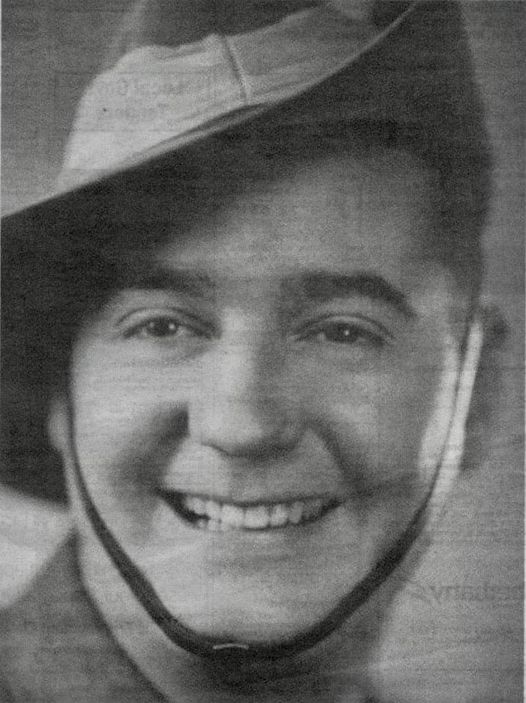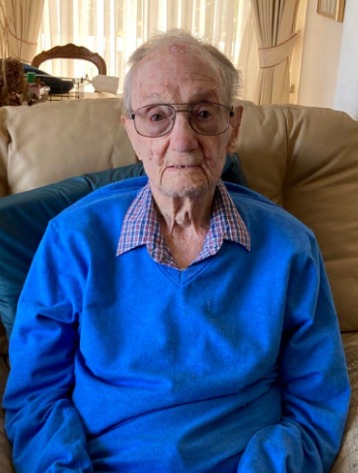JOHN CAMPBELL POPE
Born: Katanning, 1918 Died: Perth, aged 103

John Campbell Pope
“Rat of Tobruk”
TOBRUK HOUSE NEWS
Vol 132 – December 2021
We are indebted to David Warren from the West Australian for this story.
John was the son of Dr Edward Campbell Pope and was born in Gnowangerup and was the local well-known Gnowangerup doctor. In September 1913, Dr Pope was appointed as Resident Medical Officer for Gnowangerup. However, in 1915, Dr Pope relocated to Katanning to take up Dr House’s practice in Katanning.
John had an eventful life – he enlisted in World War Two and was one of the revered ‘Rats of Tobruk’ [i], a bank manager and stockbroker. He was one of Australia’s longest-lived Rats of Tobruk, had cause to be grateful for his nationality as a prisoner-of-war in Germany in early 1945.
Awaiting execution by firing squad for a failed escape bid, John and two mates, Thomas (Tom) Benjamin Comins and Allan Roy Beecroft, were in cells underneath the local Gestapo headquarters when guards, accompanied by a senior officer, brought them each a bowl of soup. Comins, who spoke fluent German heard the officer ask: “Why have these men not been shot?” Told that they were Australians, the officer could not understand why they would cross the world to fight in a conflict he perceived was not their problem so he sent the trio back to join other prisoners without any punishment.
John was born in Katanning, the third son of Dr Edward Campbell and Olive Pope. He attended Katanning Primary School before transferring at the age of 10 to board at Guildford Grammar School where he became a prefect, captain of swimming and a member of the 1935 winning Alcock Cup football team.
John wanted to go to university, but his father said that with his older brothers both studying medicine in Melbourne and two younger sisters being educated at Kobeelya Church of England Girls’ School in Katanning he could not afford it. So, John joined the Commonwealth Bank.
After the beginning of World War II, John volunteered for service and joined the WA-raised 2nd/28th Battalion, which was sent to the Middle East in early January 1941. In March, as part of the 9th Division, the battalion was sent to Libya to garrison an area east of Tobruk, a strategic deep water Mediterranean port. In April, after a strong attack by the German Africa Corps under Gen. Erwin Rommel, it was forced to withdraw to Tobruk and helped defend it for the next six months.
The Allied troops were given the name Rats after pro-German propagandist William Joyce, better known as Lord Haw-Haw began describing them as living like rats in underground dug outs and caves. The term became a badge of honour.
As a company sergeant-major, John was a major player in the 2/28th’s unsuccessful attempt to take the heavily defended German posts, known as Sugar Six and Seven, in August 1941. The action cost the battalion dearly with 88 killed, wounded or captured. John was one of those taken to Campo 57 in northern Italy.
After the Italian surrender in September 1943 John was taken to Lower Silesia in Germany. In late 1944 with the Russians advancing on the Eastern Front, the Germans started moving prisoners to the west of Germany, fearful they would become part of a larger invading force if freed by the Russians.
In late January 1945, in the middle of a freezing winter, they began a 30-day march. On day 17, John, Comins and Beecroft escaped. Their freedom lasted three days before they were recaptured, handed over to the Gestapo and taken to cells inside massive underground tunnels within a mountain near Nordhausen where V1 and V2 rockets were being made.
After avoiding execution and during an air raid in late March 1945, John, Comins and Beecroft used confusion in the camp to escape again, eventually linking up with American troops who provided them with travel passes, food and clothing. The trio then commandeered a German officer’s VW car and drove to Paris, where, uninvited, they attended a high-society cocktail party.
They were “re-acquainted” with Australian authorities after a British military policeman spotted them swanning around Paris, John conspicuous in a slouch hat. They were then transferred to Eastbourne in England, before repatriation to Australia. Despite requesting to re-join the 2/28th Battalion fighting in New Guinea, John was discharged from the army in July 1945.
Before his war service overseas, John had become engaged to Helen Brisbane. They had known each other as children in Katanning when Helen was a boarder at Kobeelya and later reconnected at a ball at the Karrinyup Golf Club.
In August 1945 and John re-joined the Commonwealth Bank in Katanning. In 1949 he was transferred to Perth, eventually being appointed CBA branch manager at Cottesloe and taking on the role of president of the CBA Managers’ Association. In 1962, John resigned and joined a stockbroking firm. He subsequently became a partner and was elected to the committee of the Perth Stock Exchange. He retired in 1986.
John was a keen punter but decided it was time to give up at the age of 97 after he drove his car, accidentally, through the doors of the Cottesloe TAB. He surrendered his driver’s licence soon after.
John kept in touch with his fellow escapees after the war. Tom Comins became one of Sydney’s leading specialist surgeons and Allan Beecroft became a chief dyer for woollen mills in Tasmania. Comins was an RAAF flight-lieutenant and Beecroft a warrant officer class one with the 2/12th Battalion. There are only 17 known Australian Rats of Tobruk still alive.
He maintained a keen interest in other sports, was a member of many clubs and lived independently until his death. He is survived by his youngest son Graham, nine grandchildren and 11 great-grandchildren. He was predeceased by sons Jonathan (2001) and Douglas (2002). David Warren.

John Campbell Pope
